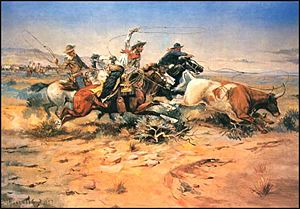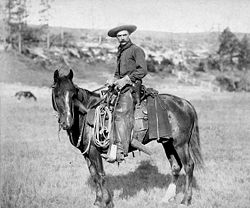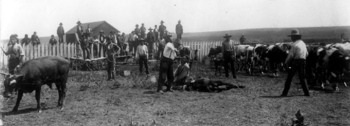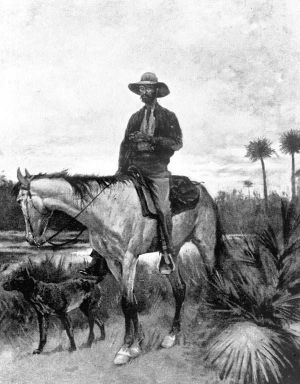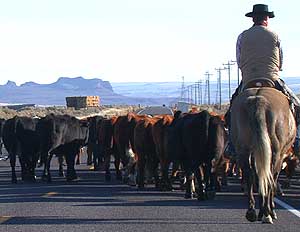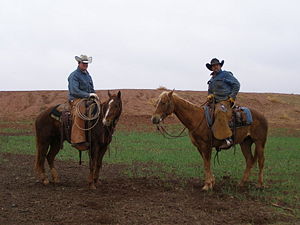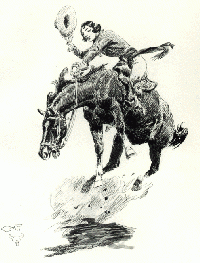Cowboy
A cowboy is an animal herder, usually in charge of the horses and/or cattle, on cattle ranches, especially in the western United States and Canada. The cowboy tradition began in Spain and was subsequently transported into North and South America, where it developed its unique and enduring character. Cowboys were an essential part of the nineteenth century American West, hired to keep a watchful eye over the large roving herds of cattle on the open range.
Today, in addition to ranch work, some cowboys work in and participate in rodeos, while some work exclusively in the rodeo. Cowboys also spawned a rich cultural tradition, made famous throughout the world through Western novels, songs, movies, and serial programs on radio and television.
Etymology
The word "cowboy" first appeared in the English language about 1715–25 C.E.[1] It appears to be a direct English translation of vaquero, the Spanish term for an individual who managed cattle while mounted on horseback, derived from vaca, meaning "cow." Another English word for a cowboy, buckaroo, is an Anglicization of vaquero.
A main difference between "vaquero" and "cowboy" is that the Spanish term lacks an implication of youth. Because of the time and physical ability needed to develop necessary skills, the American cow "boy" often began his career as an adolescent, earning wages as soon as he had enough skill to be hired, often as young as 12 or 13. In the United States, a few women also took on the tasks of ranching and learned the necessary skills, though the "cowgirl" did not become widely recognized or acknowledged until the close of the nineteenth century.
History
The Spanish cowboy tradition developed with the hacienda system of medieval Spain. This style of cattle ranching spread throughout much of the Iberian peninsula and was later exported to the Americas. Both regions possessed a dry climate with sparse grass, and thus large herds of cattle required vast amounts of land in order to obtain sufficient forage. The need to cover distances greater than a person on foot could manage gave rise to the development of the horseback-mounted vaquero.
During the sixteenth century, Spanish settlers brought their cattle-raising traditions as well as their horses and cattle to the Americas, starting with their arrival in what today is Mexico and Florida. The traditions of Spain were transformed by the geographic, environmental and cultural circumstances of New Spain, which later became Mexico and the southwestern United States.
The tradition evolved further, particularly in the central states of Mexico—Jalisco and Michoacán—where the Mexican cowboy would eventually be known as a "charro," as well as areas to the north that later became the Southwestern United States. Most of these vaqueros were men of mestizo and Native American origin, while most of the hacendados (owners) were ethnically Spanish.
As English-speaking traders and settlers moved into the Western United States, English and Spanish traditions and culture merged to some degree, with the vaquero tradition providing the foundation of the American cowboy. Before the Mexican American War in 1848, New England merchants who traveled by ship to California encountered both hacendados and vaqueros, trading manufactured goods for the hides and tallow produced from vast cattle ranches. American traders along with what later became known as the Santa Fe Trail had similar contacts with vaquero life. Starting with these early encounters, the lifestyle and language of the vaquero began a transformation which merged with English cultural traditions and produced what became known in American culture as the "cowboy."
By the 1890s, railroads had expanded to cover most of the nation, making long cattle drives from Texas to the railheads in Kansas unnecessary. The invention of barbed wire allowed cattle to be confined to designated acreage to prevent overgrazing of the range, which had resulted in widespread starvation, particularly during the harsh winter of 1886-1887. Hence, the age of the open range was gone and large cattle drives were over. Smaller cattle drives continued at least into the 1940s, as ranchers, prior to the development of the modern cattle truck, still needed to herd cattle to local railheads for transport to stockyards and packing plants.
Ethnicity of the traditional cowboy
Cowboys ranked low in the social structure of the period, and there are no firm figures as to their ethnicity. Anglos, Mexicans, Native Americans, freed Negro slaves, and men of mixed blood were certainly among them.
Texas produced the greatest number of white cowboys, probably accounting for the plurality. It is estimated that about 15 percent of cowboys were of African-American ancestry. Similarly, U.S. cowboys of Mexican descent also averaged about 15 percent, but were more common in Texas and the southwest. (In Mexico, the vaqueros developed a distinct tradition and became known as charros.) Many early vaqueros were Native American people trained to work for the Spanish missions in caring for the mission herds. Later, particularly after 1890, when American policy promoted "assimilation" of Indians, some Indian boarding schools also taught ranching skills to native youth. Today, some Native Americans in the western United States own cattle and small ranches, and many are still employed as cowboys, especially on ranches located near Indian Reservations. The "Indian Cowboy" also became a commonplace sight on the rodeo circuit.
U.S cowboy traditions
Geographic and cultural factors caused differences to develop in cattle-handling methods and equipment from one part of the United States to another. In the modern world, remnants of two major and distinct cowboy traditions remain, known today as the "Texas" tradition and the "California" tradition, which is more closely related to its Spanish roots. Less well-known but equally distinct traditions developed in Hawaii and Florida.
Texas
In the early 1800s, the Spanish Crown, and later, independent Mexico, offered empresario grants in what would become Texas to non-citizens, such as settlers from the United States. In 1821, Stephen F. Austin and his East Coast comrades became the first Anglo-Saxon community speaking Spanish. Following Texas independence in 1836, even more Americans immigrated into the empresario ranching areas of Texas. Here the settlers were strongly influenced by the Mexican vaquero culture, borrowing vocabulary and attire from their counterparts, but also retaining some of the livestock-handling traditions and culture of the Eastern United States and Great Britain. The Texas cowboy was typically a bachelor who hired on with different outfits from season to season.
Following the American Civil War, vaquero culture diffused eastward and northward, combining with the cow herding traditions of the eastern United States that evolved as settlers moved west. Other influences developed out of Texas as cattle trails were created to meet up with the railroad lines of Kansas and Nebraska, in addition to expanding ranching opportunities in the Great Plains and Rocky Mountain Front, east of the Continental Divide.
The Texas cowboy tradition therefore arose from a combination of cultural influences and the need to conduct long cattle drives to get animals to market under often treacherous environmental conditions.
California
The vaquero, the Spanish or Mexican cowboy who worked with young, untrained horses, had flourished in California and bordering territories during the Spanish Colonial period. Settlers from the United States did not enter California until after the Mexican War, and most early settlers were miners rather than livestock ranchers, leaving livestock-raising largely to the Spanish and Mexican people who chose to remain in California. The California vaquero, or buckaroo, unlike the Texas cowboy, was considered a highly-skilled worker, who usually stayed on the same ranch where he was born or had grown up and raised his own family there.
Florida cowhunters
The Florida "cowhunter" or "cracker cowboy" of the nineteenth and early twentieth centuries was distinct from the Texas and California traditions. Florida cowboys did not use lassos to herd or capture cattle. Their primary tools were bullwhips and dogs. Florida cattle and horses were small. The "cracker cow"—also known as the "native cow" or "scrub cow"—averaged about 600 pounds and had large horns and feet. [2]Since the Florida cowhunter did not need a saddle horn for anchoring a lariat, many did not use Western saddles. They usually wore inexpensive wool or straw hats, and used ponchos for protection from rain.[3]
Hawaiian Paniolo
The Hawaiian cowboy, the paniolo, is also a direct descendant of the vaquero of California and Mexico. By the early 1800s, cattle given by Captain George Vancouver to King Pai`ea Kamehameha of Hawaii had multiplied astonishingly and were wreaking havoc throughout the countryside. About 1812, John Parker, a sailor who had jumped ship and settled in the islands, received permission from Kamehameha to capture the wild cattle and develop a beef industry. This, began the tradition of the "Paniolos," a word thought to derive from a Hawaiianized pronunciation of the word, Español. Many Hawaiian ranching families today still carry the names of the vaqueros who married Hawaiian women and made Hawaii their home.
Other nations
In addition to the Mexican vaqueros, the Mexican charro, the North American cowboy, and the Hawaiian paniolo, the Spanish also exported their horsemanship and knowledge of cattle ranching to the gaucho of Argentina, Uruguay, Paraguay and southern Brazil, the llanero of Venezuela, the huaso of Chile, and, indirectly (through the U.S.) to Australia. In Australia, which has a large ranch (station) culture, cowboys are known as stockmen and drovers, with trainee stockmen referred to as jackaroos and jillaroos.
The use of horseback riders to guard herds of cattle, sheep or horses is common wherever wide, open land for grazing exists. In the French Camargue, riders called "gardians" herd cattle. In Hungary, the csikós guard horses. The herders in the region of Maremma in Tuscany, Italy are called butteros.
In Canada, the ranching and cowboy tradition centers around the province of Alberta. The city of Calgary remains the center of the Canadian cattle industry and is called "Cowtown." The Calgary Stampede which began in 1912 is the world’s richest cash rodeo. Each year, Calgary’s northern rival Edmonton, Alberta stages the Canadian Finals Rodeo, and dozens of regional rodeos are held throughout the province.
Cowgirls
There are few records mentioning girls or women driving cattle up the cattle trails of the Old West, even though women undoubtedly helped on the ranches, and in some cases ran them, especially when the men went to war. There is little doubt that women, particularly the wives and daughters of men who owned small ranches and could not afford to hire large numbers of outside laborers, worked side by side with men and thus needed to ride horses and be able to perform ranch work.
It was not until the advent of the Wild West shows that cowgirls came into their own. Their riding, expert marksmanship, and trick roping entertained audiences around the world. Women such as Annie Oakley became household names. By 1900, skirts split for riding astride, allowed women to compete with the men without scandalizing Victorian Era audiences.
The growth of the rodeo brought about another type of cowgirl—the rodeo cowgirl. In the early Wild West shows and rodeos, women competed in all events, sometimes against other women, sometimes with the men. Performers such as Fannie Sperry Steele rode the same "rough stock" and took the same risks as the men (and all while wearing a heavy split skirt that was still more encumbering than men's trousers) and gave show-stopping performances at major rodeos such as the Calgary Stampede and Cheyenne Frontier Days. [4]
Development of the modern cowboy
Over time, the cowboys of the American West developed a personal culture of their own, a blend of frontier and Victorian values that even retained vestiges of chivalry. Such hazardous work in isolated conditions also bred a tradition of self-dependence and individualism, with great value put on personal honesty, exemplified in their songs and poetry.
Today, the Texas and California traditions have merged to some extent, though a few regional differences in equipment and riding style still remain, and some individuals choose to deliberately preserve the more time-consuming but highly skilled techniques of the pure vaquero tradition. The popular "horse whisperer" style of natural horsemanship was originally developed by practitioners who were predominantly from California and the Northwestern states, clearly combining the attitudes and philosophy of the California vaquero with the equipment and outward look of the Texas cowboy.
On the ranch, the cowboy is responsible for feeding the livestock, branding and earmarking cattle, plus tending to animal injuries and other needs. The working cowboy usually is in charge of a small group or "string" of horses and is required to routinely patrol the rangeland in all weather conditions checking for damaged fences, evidence of predation, water problems, and any other issues of concern.

Cowboys also move the livestock to different pasture locations and herd them into corrals or onto trucks for transport. In addition, cowboys may do many other jobs, depending on the size of the "outfit" or ranch, the terrain, and the number of livestock. On a large ranch with many employees, cowboys are able to specialize in tasks solely related to cattle and horses. Cowboys who train horses often specialize in this task only, and some may "break" or train young horses for more than one ranch.
The United States Bureau of Labor Statistics collects no figures for cowboys. Their work is included in the 2003 category, Support activities for animal production, which totaled 9,730 workers with an average salary of $19,340 per year. In addition to cowboys working on ranches, in stockyards, and as staff or competitors at rodeos, the category includes farmhands working with other types of livestock (sheep, goats, hogs, chickens, etc.). Of those 9,730 workers, 3,290 are listed in the subcategory of Spectator sports, which includes rodeos, circuses, and theaters needing livestock handlers.
Cowboy gear
Attire
Most cowboy attire, sometimes termed Western wear, grew out of practical need and the environment in which the cowboy worked and were adapted from the Mexican vaqueros. It includes:
- Cowboy hat—with a wide brim to protect from sun, rain, overhanging brush, and the elements
- Cowboy boots—with a high top to protect the lower legs, pointed toes to help guide the foot into the stirrup, and high heels to keep the foot from slipping through the stirrup; with or without detachable spurs.
- Chaps—(pronounced "shaps") to protect the rider's legs while on horseback, especially riding through heavy brush or during rough work with livestock.
- Jeans—or other sturdy, close-fitting trousers made of canvas or denim, designed to protect the legs and prevent the trouser legs from snagging on brush, equipment or other hazards.
- Gloves—often of deerskin or other leather that is soft and flexible for working purposes, yet provides protection when handling barbed wire, assorted tools or clearing native brush and vegetation.
Parameters such as hat brim width, or chap length and material often vary to accommodate the various environmental conditions encountered by working cowboys.
Tools
- Lariat—from the Spanish "la riata," meaning "the rope," a tightly twisted stiff rope with a loop at one end enabling it to be thrown to catch animals (sometimes called a lasso or simply, a "rope").
- Spurs—metal devices attached to the heel of the boot, featuring a small metal shank, usually with a small serrated wheel attached, used to allow the rider to provide a stronger (or sometimes, more precise) leg cue to the horse.
- Rifle—a firearm used to protect the livestock from predation by wild animals. A pistol might also be carried.
- Knife—traditionally a pocket knife, specifically the folding cattle knife which evolved into the stock knife still popular today.
Horses
The traditional means of transport for the cowboy, even in the modern era, is on horseback. Horses can traverse terrain vehicles cannot. Along with mules and burros, they also serve as pack animals. The most important horse on the ranch is the everyday working ranch horse. Specialized horses trained with skills such as roping or cutting are very rarely used on ranches.
A good stock horse is on the small side, generally under 15.2 hands (62 inches) tall at the withers and under 1000 pounds, with a short back, sturdy legs and strong muscling, particularly in the hindquarters. The horse has to be intelligent, calm under pressure and have a certain degree of "cow sense"—the ability to anticipate the movement and behavior of cattle.
Popular culture
As the frontier ended, the cowboy life came to be highly romanticized. Exhibitions such as those of Buffalo Bill Cody's Wild West Show helped to popularize the image of the cowboy as an idealized representative of the tradition of chivalry.
In the 1930s and 1940s, Western movies popularized the cowboy lifestyle but also formed persistent stereotypes. In pop culture, the cowboy and the gunslinger are often associated with one another. In reality, working ranch hands had very little time for anything other than the constant, hard work involved in maintaining a ranch. Likewise, cowboys are often shown fighting with American Indians. However, the reality was that, while cowboys were armed against both predators and human thieves, and often used their guns to run off people of any race who attempted to steal, or rustle cattle, nearly all actual armed conflicts with Native Americans were waged by cavalry units of the U.S. Army.
In today's society, there is little understanding of the daily realities of actual agricultural life. Cowboys are more often associated with (mostly fictitious) Indian-fighting than with their actual life of ranch work and cattle-tending. Actors such as Gary Cooper and John Wayne are thought of as exemplifying a cowboy ideal, even though western movies seldom bear much resemblance to real cowboy life. Arguably, the modern rodeo competitor is much closer to being an actual cowboy, as many were actually raised on ranches and around livestock, and the rest have needed to learn livestock-handling skills on the job.
Notes
- ↑ Definition of "cowboy" dictionary.reference.com. Retrieved November 10, 2007.
- ↑ Georgia Tasker, 2007. "Rancher preserves Florida's Cracker history." Miami Herald. February 06, 2007. origin.miami.com. Retrieved February 21, 2007.
- ↑ Jim Bob Tinsley. Florida Cow Hunter. (University of Central Florida Press, 1990. ISBN 0813009855), 42-43.
- ↑ Lenore McKelvey Puhek, "Fannie Sperry Made the Ride of Her Life" www.historynet.com. Retrieved November 10, 2007.
ReferencesISBN links support NWE through referral fees
- Beck, Warren A. and Ynez D. Haase. Historical Atlas of the American West. University of Oklahoma Press, Oklahoma, 1989. ISBN 978-0806121932
- Jordan, Teresa. Cowgirls: Women of the American West. Bison Books, 1992. ISBN 978-0803275751
- Lamar, Howard R. (Editor) The New Encyclopedia of the American West. Yale University Press; Subsequent edition, 1998. ISBN 978-0300070880
- Nicholson, Jon. Cowboys: A Vanishing World. St. Martin's Press, 2001. ISBN 978-0312286774
- Roach, Joyce Gibson. The Cowgirls. University of North Texas Press, 1990. ISBN 978-0929398150
- Slatta, Richard W. The Cowboy Encyclopedia. W. W. Norton & Company, 1996. ISBN 978-0393314731
- Tinsley, Jim Bob. Florida Cow Hunter. University of Central Florida Press, 1990. ISBN 0813009855
- Ward, Fay E. The Cowboy at Work: All About His Job and How He Does It. University of Oklahoma Press. 1987. ISBN 978-0806120515
External links
All links retrieved January 11, 2024.
- American Cowboy Information – History, facts, and current trends. www.truecowboy.com.
- National Cowboy and Western Heritage Museum. www.nationalcowboymuseum.org.
- Cowgirl Hall of Fame Website. www.cowgirl.net.
- Working Ranch Cowboys Association. www.wrca.org.
Credits
New World Encyclopedia writers and editors rewrote and completed the Wikipedia article in accordance with New World Encyclopedia standards. This article abides by terms of the Creative Commons CC-by-sa 3.0 License (CC-by-sa), which may be used and disseminated with proper attribution. Credit is due under the terms of this license that can reference both the New World Encyclopedia contributors and the selfless volunteer contributors of the Wikimedia Foundation. To cite this article click here for a list of acceptable citing formats.The history of earlier contributions by wikipedians is accessible to researchers here:
The history of this article since it was imported to New World Encyclopedia:
Note: Some restrictions may apply to use of individual images which are separately licensed.
